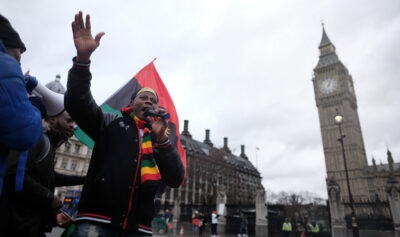 The Super Bowl is an annual ritual celebration of the classical virtues embodied in the game of football, virtues that help fortify our national character. I know that not everyone will see so much in the event. For some critics, the Super Bowl is a mere spectacle, empty pomp and crass consumerist craze, all as meaningless as the silver glitz of the Patriots cheerleaders’ pom-poms. Indeed, even the architect who designed the stadium where the game will be played posits a theory to undermine any pretense of classical virtues or abiding ideals. Peter Eisenman claims to apply Derrida’s deconstruction to architecture. Like any unstable signifier in post-structuralist theory, his stadium has already changed names since opening only a few years ago. No longer Cardinals Stadium, it is now University of Phoenix Stadium, a name paid for by the popular on-line university. But by any name, the brushed steel structure gleams under the sun and stars like an uncanny cactus in the middle of the Arizona desert. It is visible for miles because there is nothing around. It is a shining beacon of nowhere – an “atopia,” in Eisenman’s terms – a meaningless no-place where will happen meaningless non-events, such as the Super Bowl. Or if not meaningless, the event offers only the superficial good of being “good for the economy.” Before the game, you can pay $150 to enter a “ V.I.P.” party tent to mingle with “celebrities” and pay $8 more for bottle of water. Super Bowl Weekend incites a constant media cycle of reportage and commentary, an unending media spectacle beckoning our attention – 140 million viewers! – attention advertisers will pay dearly to capture. During the game, thirty seconds of screen-time will cost as much as $2.7 million.
The Super Bowl is an annual ritual celebration of the classical virtues embodied in the game of football, virtues that help fortify our national character. I know that not everyone will see so much in the event. For some critics, the Super Bowl is a mere spectacle, empty pomp and crass consumerist craze, all as meaningless as the silver glitz of the Patriots cheerleaders’ pom-poms. Indeed, even the architect who designed the stadium where the game will be played posits a theory to undermine any pretense of classical virtues or abiding ideals. Peter Eisenman claims to apply Derrida’s deconstruction to architecture. Like any unstable signifier in post-structuralist theory, his stadium has already changed names since opening only a few years ago. No longer Cardinals Stadium, it is now University of Phoenix Stadium, a name paid for by the popular on-line university. But by any name, the brushed steel structure gleams under the sun and stars like an uncanny cactus in the middle of the Arizona desert. It is visible for miles because there is nothing around. It is a shining beacon of nowhere – an “atopia,” in Eisenman’s terms – a meaningless no-place where will happen meaningless non-events, such as the Super Bowl. Or if not meaningless, the event offers only the superficial good of being “good for the economy.” Before the game, you can pay $150 to enter a “ V.I.P.” party tent to mingle with “celebrities” and pay $8 more for bottle of water. Super Bowl Weekend incites a constant media cycle of reportage and commentary, an unending media spectacle beckoning our attention – 140 million viewers! – attention advertisers will pay dearly to capture. During the game, thirty seconds of screen-time will cost as much as $2.7 million.
This might be the story of Super Bowl XLII (as written by deconstructive theory or the Glendale, Arizona chamber of commerce), except for the game. The game is the saving grace. The game embodies classical virtues and manifests a transcendent good that saves us from the purely gratuitous. For example, the New England Patriots recall Roman virtus. What we may call virtue or excellence, the human capacity for practical good, the Greeks called arête, meaning a kind of virtuosity, exemplified in the courage of Achilles or the cunning of Odysseus. When the Romans translated the Greek ethos as virtus, they emphasized the communal rather than the individual heroic aspect of excellence. So Roman virtus was exhibited in the coordinated courage and discipline of the legions in action, accomplishing complex maneuvers in the thick of battle over difficult terrain and to lethal effect. This virtue of team-work must be prized by all large working groups, not only football teams, but also corporations and the military. The New England Patriots exemplify this virtue. Their offense operates with Roman precision and effectiveness. There are no egos on the Patriots. In an American culture that caters to insatiable desires and superficial self-interests, selflessness and disciplined cooperation are welcome lessons.
In Virgil’s Aeneid, Rome’s legendary founder Aenais embodied this virtus, and so does Patriots quarterback Tom Brady. Brady’s demeanor and decisiveness tell more than any physical virtue. More than the strength of his arm, Brady’s analysis of opposing defenses and ability to employ every weapon in the multifarious Patriots’ arsenal has made his team the most potent offense in NFL history. Brady proves why prudence, or practical wisdom, is thought of as the ruling virtue.
A contrast to Brady’s quiet confidence is Giants receiver Plaxico Burress. Burress has boldly predicted a Giants win, even specifying a final score. Although Burress has tried to back off from his prediction, saying that he was just trying to be “entertaining” (and isn’t such entertainment harmless fun and anyway good for the economy?), such comments are typical of Burress who, after catching a touchdown pass, ostentatiously bows to the four corners of the field and then, with all eyes upon him, just as ostentatiously kneels to pray (an odd combination, the pious punk).
Earlier in the season, in responding to a similar prediction by a proud opponent, Brady pithily replied (quoting a fellow patriot, Ben Franklin): “Well done is better than well said.” This is a maxim worthy of Seneca. It distills the very essence of ancient virtue, and the saving grace of today’s game. The good cannot be completely known, cannot be completely said. As Plato instructed, the good is beyond being, beyond rational prediction and control, no matter how well-said. The good is best recognized in action. And the good will be known by the comparative difference between good and better. “Well done is better than well said.”
Although the stadium’s architect has argued for the insignificance of his buildings, he has somehow betrayed his own words in having created a stunning setting for a football game. Perhaps his heart has betrayed his mind. Peter Eisenman is, in fact, a long-time Giants fan and season-ticket holder. And Plaxico Burress, despite his words of hubris, is an excellent player who shows speed, leaping ability, soft-hands, toughness and panache. You can watch Burress catching balls from Eli Manning all night long. His individual virtues were displayed in the last regular game of the season in which the Giants played against the Patriots. Both teams having secured play-off berths, this was supposed to be a meaningless game in which stars, such as Brady and Burress, ought to be rested and kept safe from injury. But with nothing but pride on the line, both teams fought gloriously. Let the Super Bowl be as “meaningless” as that final game of the season and we will have a good game on our hands indeed.
A good game will put all the silver glitz in its proper perspective. The game will be seen as an epiphany of the good, exemplifying physical virtues and intimating corresponding spiritual ideals. The teamwork of the Patriots, the calm decisiveness of Brady, the courage and flair of Burress offer lessons that can be translated over into everyday life. Enjoy the game.













Obviously it draws a large number of viewers but how broad a spectrum of society is represented by the players? Consider some standard dimensions.
Globalism. The Olympics, Wimbledon, the World Cup and other international soccer competitions are global. Teams or players come from all over the world. By comparison, American football, the sport of the Super Bowl, is largely confined to America, meaning North America and primarily USA.
Gender. The Olympics, tennis, soccer feature both male and female. In fact, women are among the glamorous stars, such as the Williams sisters, Mia Hamm, and the still remarkable Marion Jones. American football is largely male. Women at the Super Bowl are cheer leaders, spectators, and entertainers like the much-ogled Janet Jackson.
Race. Players in the super bowl are largely black and white. Asians, Hispanics, and others are rare. Baseball and basketball boast a much wider racial or ethnic spectrum.
Age. For obvious reasons, a super bowl player over forty or under twenty is a rarity.
So, the Superbowl is not super by virtue of broad representation among its players of global, gender, racial, or age dimensions.
Some other dimensions, such as class and region, are more broadly represented. Many but not all players graduated from college and their class backgrounds vary fairly broadly. Also, they come from all over the United States. It so happens that three of the four quarterbacks in the playoffs this year came from the deep South (Eli Manning, Brett Favre, and Philip Rivers) but Tom Brady is a Californian playing for New England. Manning plays in New York, Favre in Wisconsin, and Rivers in California.
What about religion? Here I’d like to shift perspectives. The interesting thing is not the variety represented among players, which has increased over the past few years as Christians have been supplemented by Muslims and others. The interesting thing is that religion is on the whole not an identity that divides teams. None of the professional teams is identified with a particular religion the way it is identified with a particular city. Religious identities do enter into college teams somewhat, inasmuch as some colleges such as Notre Dame or Boston College are Catholic and others are not. Also religious rituals, such as prayer before games or the sign of the cross as a gesture, sometimes enter the game. But claims that one is led by God are usually made by individuals not teams. While sectarian identities drive many “clashes of civilizations” that lead to terrorism and wars, such identities are seemingly not salient in big-time sports in the USA including the Superbowl. Rivalries are not driven by religion.
Politics? Neither the Patriots nor the Giants have, so far as I know, come out for Obama, Clinton, or McCain. Patriots may sound patriotic but do not as a team necessarily endorse Republicans or Democrats.
So far, a couple of things impress about the Super Bowl. First, the teams are not impressive by their social scope. The teams are not global, not inclusive in gender, and they are fairly narrow in ethnic or racial makeup. In this sense, they are narrow rather than broad. Second, however, the teams have avoided a religious or political claim or identity; these teams differ therefore from two major identities that divide groups (tribes, nations, etc.) and lead to conflict and war. In this sense, they are broad rather than narrow.
What’s the point? To delineate some things the Super Bowl is not. Why bother? To place it in perspective. Consider the range of identities important in today’s world: global identities, gender, race, ethnicities, religion, etc. (For examples, see Identities Matter: Ethnic and Sectarian Conflict.) It is noteworthy that the Super Bowl and American football generally do not deploy some of the obvious possibilities rife in the world today: broadening in terms of global, gender, and ethnic identity or narrowing to a particular religious or political identity.
What does the Super Bowl represent? A certain kind of Americanism.The Super Bowl is quintessentially USA, especially in a pre-global, pre-multicultural and culture-clash, pre-feminist mode. Rather than featuring social categories and trends emerging or dominant in the twenty-first century, it features a particular ethos long dominant in America’s mythology and practice: macho physical power, shrewd tactics, capitalism, winner-take-all.
Of course, we all knew that all along, but comparison reminds us of alternative options.
Super Bowl Sunday has become a high holy day in the civil calendar of the United States. It is a special time for families and friends to gather together in celebrative exuberance. Weighty meaning of the day attracts the participation of many millions, most of whom have little interest in the game itself. Super Sunday brings festive atmosphere across the country, the inspiration for much drinking and feasting. The release of new ads for consumer products and services marks the festivities, generating a celebration of American devotion to innovation and persuasiveness. Perhaps more than anything else, the intense and incessant talk about the game displays set apart quality of the event. Ultimately, the spirited talking leads to the national anthem and the direct expression of civil significance. Each year, someone sings the old anthem with new passion and personal style, punctuated by the fly over of jets from the Air Force and surrounded by huge flags, the sacred symbols of national productivity and power. Quite unlike the playoffs and regular season, the Super Bowl takes place in a warm weather site, offering the near perfect setting to match the lofty thoughts and feelings about the game. Thousands travel long-distance in pilgrimage-like effort to show great depth of faith. Once associated more with the World Series, the festive sense of something sacred arises on Super Bowl Sunday.
In the twentieth century, three sports (i.e., football, baseball, basketball) emerged as supreme in the United States, consecrated with extraordinary status by national institutions of media, government, and business. Annually, the sports trinity interacts to provide a comprehensive and in-depth illustration of the ingredients for American civil religion. Football illustrates the elements of realism in the national culture, producing an ultimate concern for the recognition of life as it is. Baseball portrays the idealistic qualities of the nation, the vision for a much better life to come, while basketball presents pragmatic philosophy of the country, a dedication to fast-paced progress towards an ideal future. For decades, baseball remained supreme in the trinity of American sports. More recently, however, football reigns superior, elevating the Super Bowl to the holiest of days in the United States. The high and mighty position of football in general and the Super Sunday in particular displays growing exaltation of one stream within American civil religion, the elements associated with a perspective of realism. The Super Bowl is a celebration of the game’s sovereign place in American society, an expression of reverence for a contemporary version of the civil faith.
Dramatized by the Super Bowl, football illustrates American mythology of the hostile character to life within history. Each team faces an opponent driven by intense hostility, depicting a resemblance to chronic enemies of the nation such as the Communists of old and Muslim fundamentalists today. On the gridiron, players encounter hostile conditions of nature (e.g., ice, wind, snow, rain) like the pioneers of history and present-day homeowners. At the center of attention on Super Sunday, football portrays national story of sacred departures, an illustration of the devotion to sharp movements away from the surrounding circumstances in search for fulfillment somewhere else. Similar to the immigrants of American lore and the quick to move citizens today, the teams strive for dramatic departures away from the present location to pursue success in the distance of the end zone. With an extraordinary vigor, participants in the Super Bowl quickly depart from the unfulfilling now of game action to seek a future accomplishment, a portrayal of the country’s devotion to a hurried lifestyle. Similar to inventors of mythic significance for the nation (e.g., Bell, Gates), a “genius” or “mastermind” of a head coach frequently leads a team into the Super Bowl, an exemplar of supreme commitment to depart the old way of play in pursuit of novel strategy. Even more directly, the game on Super Sunday showcases the dedication in the United States to dramatic departure from the ground in pursuit of achievement in the world above. Resembling the core icons of the country (e.g., the airplane, skyscraper), the players rise up from the earth with great intensity on every play of the game, striving to remain elevated over the progress-killing ground. Especially on Super Sunday, football illustrates the American narrative of sacred departures from the hostile and adverse conditions of history. The exalted status of the Super day reveals the increasingly dominant and unchecked power of a particular story-line in mass culture of the nation.
The holy character of the Super Bowl discloses the supremacy of certain elements within American civil religion. In ethical beliefs, the game displays a devotion to the obedience of commands of designated authorities, as every play is dictated from the coaches on the sidelines. Informed by the myth of a hostile world, football expresses a dedication to efforts as a collective unit in strong restraint of individuality, the just use of violence, and the acquisition of power over ever more territory. Concerning social life, the Super Bowl features a growing dedication to separation from outsiders and hierarchical relations in domestic affairs. Teams work to use the ball strictly separate from all others. They feature a chain of command, depicting a clearly established structure for authority in the country, particularly for times of crisis such as the years after 9-11. Reaching into every facet of living, the play on Super Sunday discloses an increasingly dissatisfied experience of life, a numinous sense of unsettling distance from anything ideal, generating the sensibility of never being content with the present situation. The players nurture an intense discontentment in order to succeed on the field, in possession of a nasty demeanor to fuel the acts of aggression. In illustration of American concern for personal rebirth, the players undergo dramatic shifts in persona. They move from a stationary posture to a raging dynamo of motion with each snap of the ball. The pomp and circumstance of the Super Bowl display the increasingly lofty position given to a particular set of qualities from American civil religion, while representing a sharp decline in concern for the elements of idealism and pragmatism: less and less commitment to pursue the ideals of individuality, nonviolent competition, generosity, social integration, equality, and the experience of personal contentment. On to the watching of one more Super Bowl!
On the other hand, it’s just entertainment. I’m from the UK and (real) football’s my game. I don’t like and don’t watch our most similar game to yours, rugby (league or union). But your football is really good entertainment.
This year I had the additional incentive to stay up and watch until 3am our time – my daughter is working in Ohio and was watching with her boyfriend, a Giants fan, so I went for the underdogs too. Needless to say text messages were flying across the atlantic throughout the game.
Cricket is a predominently old British Empire game, so if we hadn’t been such imperialists that would have remained a British game. Not all sports travel well. The NFL promoted AF in the 80’s which kick started some European teams, but it didn’t catch on too well. NFL’s latest ploy, playing games at Wembley, appears to be doing better.
Ron, football expresses elements of separatism in American culture. Of the major three sports, it is the most exclusive to the United States. Almost no one else on earth plays the sport. Conversely, baseball is more about integration, as it requires continual interaction in an opportunity giving way to the opponent. Relatedly, baseball is quite international, making possible a “World Classic” of play. I’m a fan of cricket too and use illustrations of the game in my classes.
In a rejoinder to the original post, and along some of the comments, two points.
First, on the positive side: Super Bowl and more generally, the entire civic culture in America of watching, playing, following, and being fans, in this game is certainly a major part of what has been called civic religion by Walzer, or ‘secular religion’ by some others. It is a strong ‘religion’ that mobilizes civic membership, solidarity, participation, and in doing so across – and regardless of – people’s actual religious affiliations, it promotes (one hopes, at least) a civic culture that steps away from the narrower, parochial faith-identities by an inch or so. Normatively, the better way to think about Super Bowl’s ‘religious’ part is then precisely by freeing it from the incidental gestures of individual players, such as Burgess’ prayers, and instead seeing in it a ‘secular’ religion that binds peoples across religions into a civil community.
Second, in a critical note: indeed to be noted is the fact that the Super Bowl, and American football, are very much American, and US specifically. It sounded somewhat odd to me (not an American) that the Giants were announced “The World Champions” in the most official and solemn way. Practically, of course, if the entire world indeed tried to compete, it would still be an American team winning, most likely. But the problem is elsewhere: this just classically belongs to the category that stands for the proverbial American parochialism, the shallow awareness about the rest of the world, and the often apparent self-congratulatory, if only sub-conscious, thought that America *is* the world as far as it matters “to me”. So, properly speaking, the Giants are not World Champions, but US Champions – and very gloriously so.